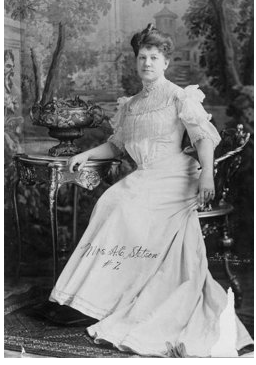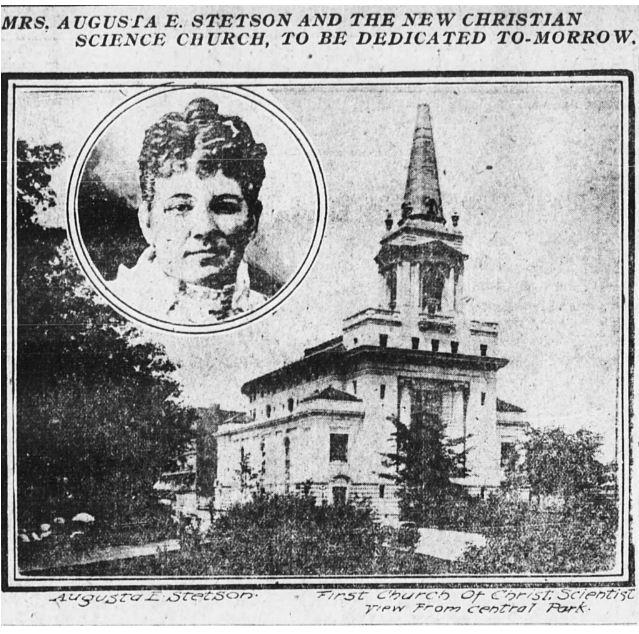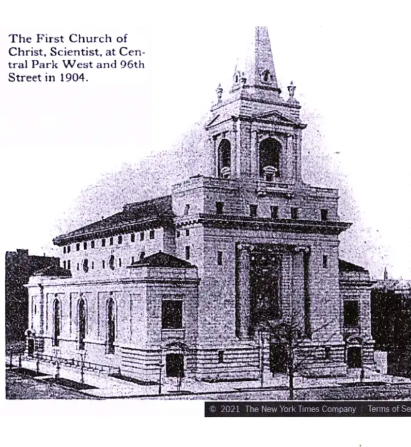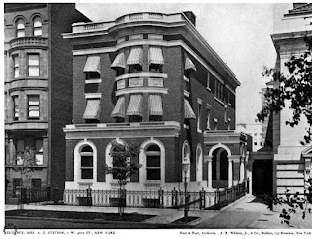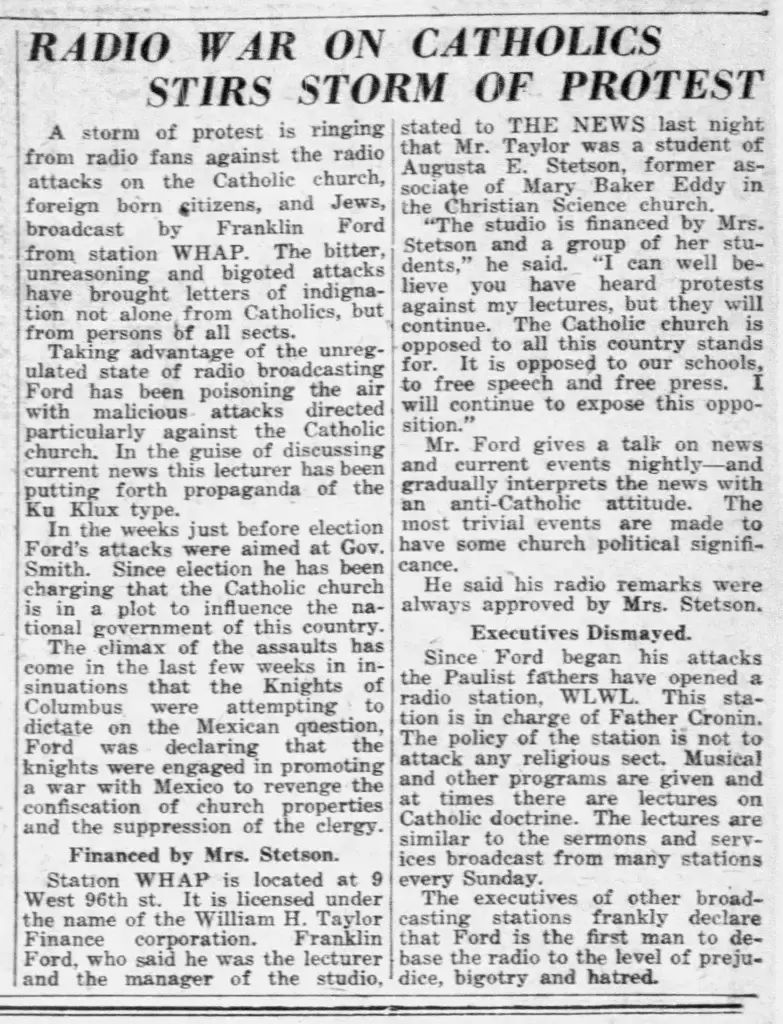|
by Pam Tice, member of the Bloomingdale Neighborhood History Group Program Committee The First Church of Christ Scientist, at 96th Street and Central Park West, will soon become the home of the Children’s Museum of Manhattan. Recent announcements of the conversion led me to look at the history of this imposing granite structure. It is a tale of two (or maybe three) women seeking power in the public sphere as they struggled to dominate in a new American religion, Christian Science. The church was the project of Augusta Stetson, who came to New York City in 1886 to establish the Christian Science church here, working at the behest of Mary Baker Eddy, the Bostonian founder. Augusta Emma Simmons Stetson was born in 1842 in Maine and raised in a strict Methodist home. When she was 22 years old, she married Captain Frederick J. Stetson, a veteran of the Civil War, and a shipbuilder with an association with a company in London. The couple left the United States to live in London, and then in Bombay, India, and in Akyab, in British Burma, for a number of years. The Stetsons returned to Boston in the 1880s when Mr. Stetson’s health declined. Augusta enrolled in the Blish School of Oratory with the idea she could earn money to support the couple by giving public lectures. She sought to become an elocutionist at a time when the public lecture circuit was popular. For her to consider entering the public sphere during Victorian times--when women were expected to stay confined to home duties--speaks to Stetson’s drive to become a public figure and a leader. She is described in many biographies as tall, elegant in appearance, with a charismatic personality and a resonant voice. In 1884, Stetson attended a lecture by Mary Baker Eddy. Soon, she was recruited by Mrs. Eddy to receive the 3-week training at the Massachusetts Metaphysical College, founded by Mrs. Eddy to teach the metaphysical healing she named Christian Science. Mrs. Eddy had developed her new religion over the past 20 years, seeking to provide help to people with physical ills at a time when medicql professionals were often unable to do so. Soon, Mrs. Stetson was dispatched to New York City to help organize Christian Scientists there. By 1890, she formally organized the First Church of Christ Scientist with herself as the ordained pastor. Later, that title would be changed to “reader” by the church. The following year, she organized the New York City Christian Science Institute. But others were at work organizing in New York City also, especially Laura Lathrop, who became Stetson’s rival. In 1891, Lathrop established the Second Church, opening her white marble building in 1903, several blocks south of Mrs. Stetson’s site. (It took until 2005 for the two congregations to join each other.) Mrs. Stetson’s invalid husband eventually came to New York in 1899 to live with her, but he died in 1901. Those years were very busy ones for her. There were increasing alarms about the practice of Christian Science, especially from doctors. Some resulted in legal cases that were reported in the press. Mrs. Stetson was increasingly viewed as a rival to Mrs. Eddy. Mrs. Eddy used a male Board of Directors to try to bring Mrs. Stetson in line. They used the mechanism of changing their rules to deal with her. In 1902 the Board limited the term of a “reader,” the name given to a Christian Science pastor, to three years. But Stetson continued in her dominant role, dubbed “Fighting Gus” by some, and managed to raise all the money needed to build the church at 96th Street. But attacks on her grew, and sometimes reached the newspapers. She was called a dictator who eliminated dissidents in her congregation and then tried to ruin their reputations. The cornerstone of Stetson’s church was laid on November 30, 1899. The contents included a letter from Mrs. Eddy, copies of books and pamphlets published by the society in Boston, the names of the members of the First Church, a number of gold and silver coins, and a copper cent of 1866, the year that Mrs. Eddy wrote her text establishing the church. Initially, the church was to cost $500,000, but it grew to over $1 million as design changes were made, including the use of Concord granite and the installation of two elevators. The First Church of Christ Scientist was dedicated November 29, 1903. Stetson used the occasion to flaunt her accomplishment of raising all the money needed, unlike her rival Latham, who had a mortgage on her church. The church building was a symbol of a congregation seeking respectability. As the 1974 Landmark Commission report says “nothing was spared in the creation of the building: the architects were prestigious (Carrere & Hastings) …and the finest material, white Concord granite, was used.” The church seated 2,200 and had a large reading room above the auditorium. Long walnut pews lined the sanctuary’s marble floor. The congregation was made comfortable with heating vents in the floor and natural light flooding in through the large windows and skylights. Numerous chandeliers made of gold hung from the ceiling. Famed artist John LaFarge made the stained glass window above the main entrance. The best source of interior views now is the photos placed at this site. The year after the church was dedicated, her devoted congregation raised the money to build Augusta Stetson a mansion just behind it, at 7 West 96th Street. (In some articles it is designated as Number 9.) Designed by Hunt & Hunt --the architectural firm of Richard Morris Hunt’s two sons--the marble mansion had a one-story portico with marble columns at its side entrance. In 1909, the First Church’s overflowing crowds caused Stetson to begin work on creating another branch on Riverside Drive at 86th Street. However, this violated the guidelines set by the Boston Directors of the Church and the plan was dropped. That same year, following another investigation into Mrs. Stetson’s “unorthodox views” and practices, including giving false testimony in a court case, the Boston Board of Directors revoked Mrs. Stetson’s license as a Christian Science teacher and practitioner, excommunicating her from the church. When Mrs. Eddy died in 1910, many expected Stetson to return to head the church, but she did not. Instead, she kept her mansion, and kept her title as the principal of the New York City Christian Science Institute. Stetson continued to publish pamphlets on her views of Christian Science, and then began attacking the “Mother church” in Boston as exhibiting “spiritual decline.” Many people in New York City continued to follow her, with as many as 800 attending her lectures. In 1918, she formed a Choral Society as part of the Institute, and took on an interesting cause: changing the third stanza of the “Star Spangled Banner” because the original verse was too militaristic and un-Christian. She composed a new anthem which was sung during World War I. In 1921, Mrs. Stetson was in the news again regarding her suit against the First Church to stop them from erecting a brick wall ten feet from the rear of the church (labeled a “spite wall”), shutting off her home from light and air. Stetson purchased a radio station in 1925, broadcasting five times a week. Unfortunately, she promoted ugly propaganda, popular at the time, that was anti-Catholic and anti-Semitic and about preserving the United States’ white supremacy and traditional American virtues. Although she had claimed immortality, Augusta Stetson died in 1928 in Rochester, New York, while visiting her nephew. Her residence was demolished soon after, and an apartment building replaced it in 1930.
As for the First Church of Christ Scientist, it continued with a congregation that shrank over time, as did many churches. The Crenshaw Christian Center East, a nondenominational church from Los Angeles, purchased the building in 2004 and held services there for a decade. In 2014, a developer purchased the building with the intention of converting it into condominiums. That project failed. Now, the Children’s Museum of Manhattan plans to convert the space and join the neighborhood’s other important institutions. P.S. After I posted this piece, Vita Wallace, who handles the Bloomingdale History Group’s Library Collection, notified me that she had a copy of a real estate brochure that was created when the First Church of Christ Scientist was put on the market for sale. She has now uploaded it to the BNHG’s site, and here it is here. This piece has several photographs of the Beaux Arts interior of this beautiful building before it was gutted. Sources Swenson, Rolf “ ‘You Are Brave But You Are A Woman in the Eyes of Men’: Augusta E. Stetson’s Rise and Fall in the Church of Christ Scientist” Journal of Feminist Studies in Religion, Spring, 2008, Volume 24, No.1, pp75-89 James, Edward T., ed. Notable American Women 1607-1950. Cambridge, MA.: The Belknap Press of Harvard University, 1971 Benowitiz, June Melby Encyclopedia of American Women and Religion, Vol 2. Santa Barbara, CA: ABC-CLIO, 2017 McDonald, Jean A. “Mary Baker Eddy and the Nineteenth Century ‘Public’ Woman: A Feminist Reappraisal” Journal of Feminist Studies in Religion, Spring 1986, Volume 2, No 1, pp 89-111 Newspaper databases at the New York Times and newspapers.com http://daytoninmanhattan.blogspot.com/ www.untappedcities.com.
0 Comments
Leave a Reply. |

